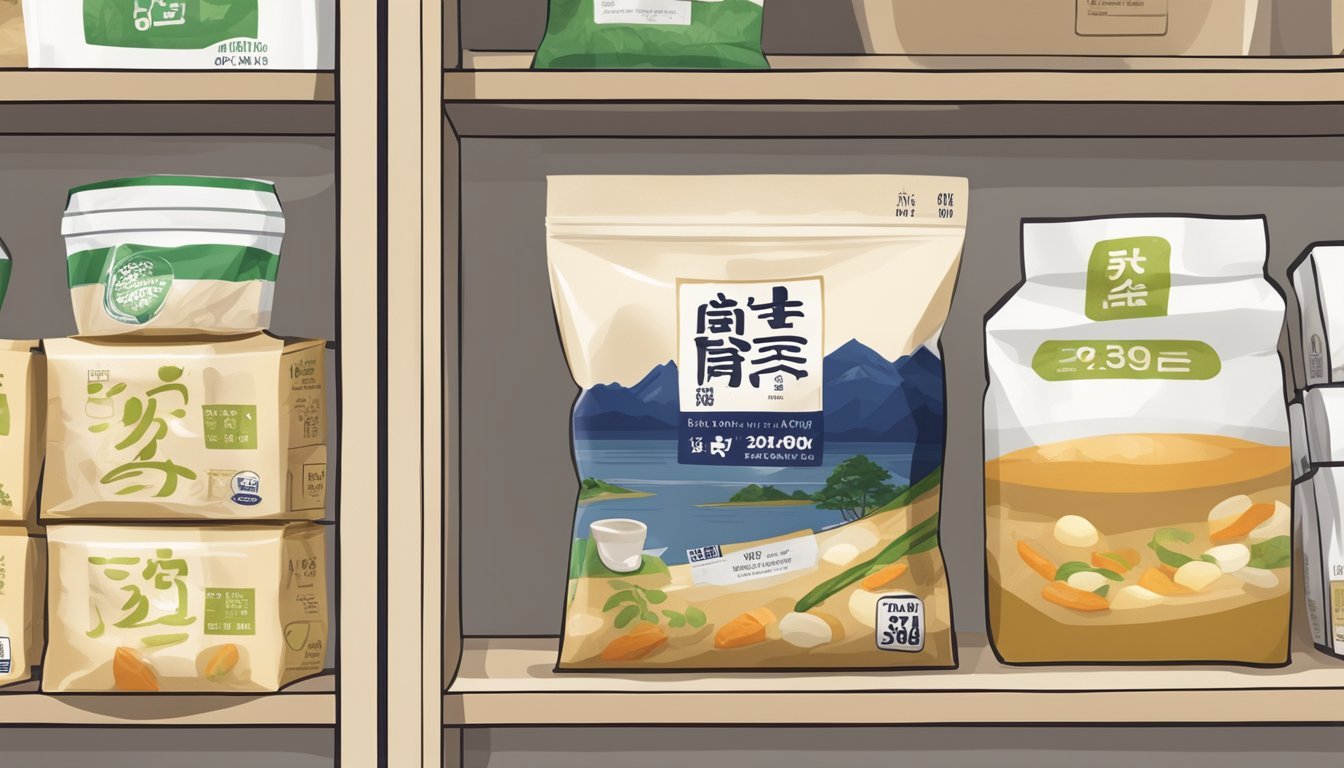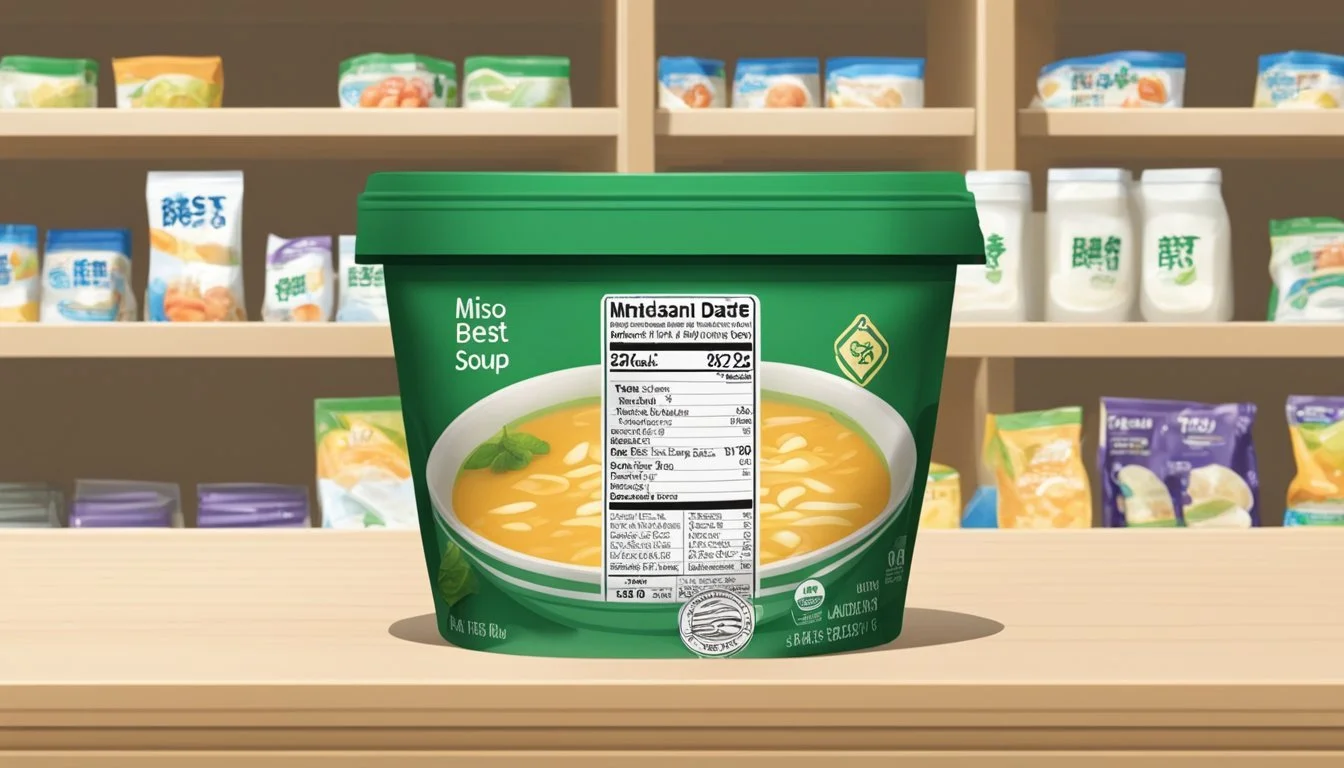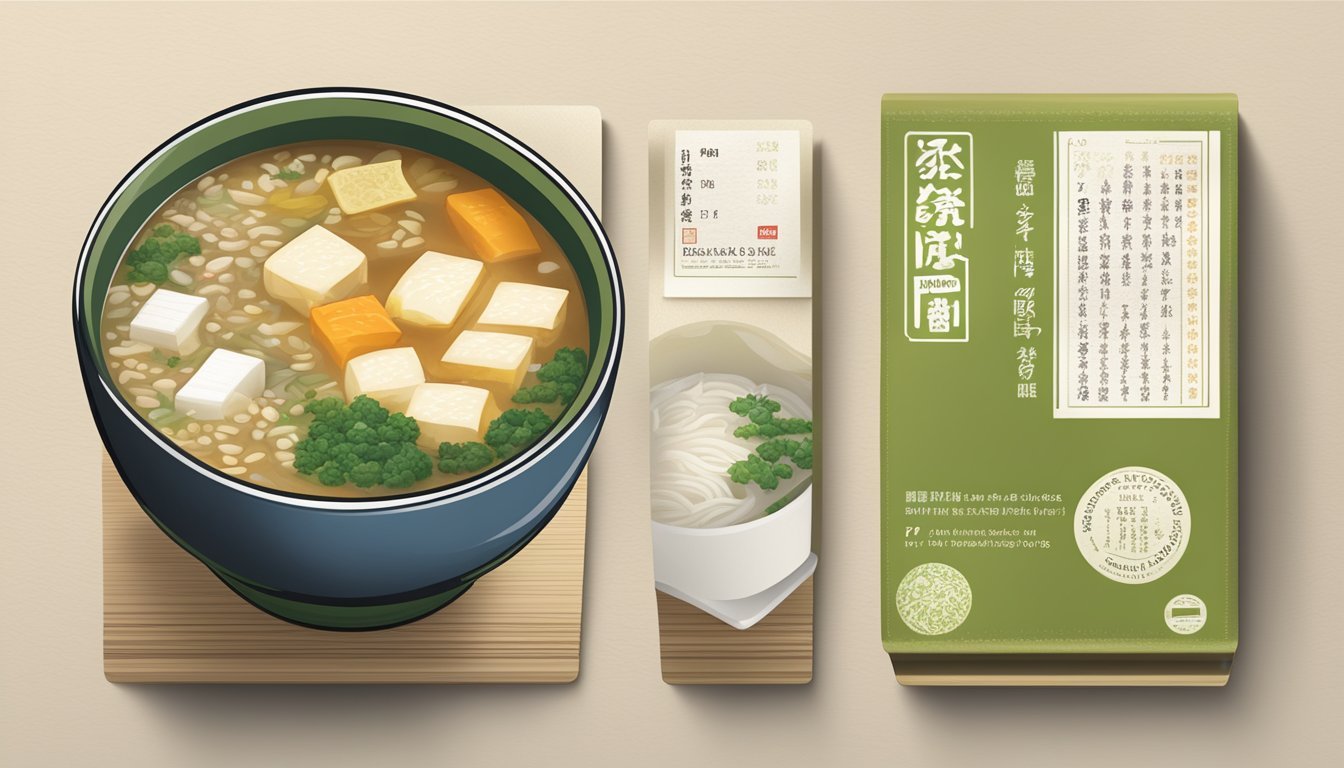How Long Do Miso Soup Packets Last?
Shelf Life and Storage Tips
Miso soup, a staple in Japanese cuisine, is enjoyed for its rich, savory flavor and its simplicity in preparation, especially when it comes to instant miso soup packets. These packets provide a convenient way to savor this traditional dish without the lengthy process of making it from scratch. The longevity of miso soup packets is of interest to consumers who value both convenience and minimization of food waste.
Instant miso soup packets tend to have a long shelf life, typically lasting at least two years when stored properly. This is due in part to the natural preservative properties of miso paste, which is a fermented food containing salt. However, the addition of other ingredients like dashi can affect its shelf life. Proper storage in a cool, dry place is crucial to maintaining the quality and safety of the miso soup packets over their lifespan.
Understanding the factors that contribute to the shelf life of miso soup packets can assist consumers in making informed decisions about purchasing and storing this convenient product. It is always advisable to check the expiration date provided by the manufacturer and adhere to the storage guidelines to ensure the best quality of the miso soup when consumed.
Understanding Miso Soup
Miso soup is a traditional Japanese soup consisting of a stock called dashi into which softened miso paste is mixed. It often contains additional ingredients such as seaweed, tofu, and vegetables.
Key Ingredients
Miso Paste: This is a fermented product made from soybeans, (how long do soybeans last?) salt, and koji (a type of fungus). It's the base flavor of miso soup.
Dashi: A broth typically made from kelp (seaweed) and shaved bonito flakes, providing the soup with its umami quality.
Tofu: Soft cubes added for texture and protein.
Seaweed: Often wakame is used, which rehydrates quickly in the warm broth, enhancing taste and nutrition.
Additional Ingredients: Vegetables or other proteins can be added, which vary by region and preference.
The Role of Fermentation
Fermented Soybeans: Fermentation of soybeans in miso paste contributes to the complex flavor and preservative qualities of the soup.
Extended Shelf Life: The fermentation process gives miso paste a longer shelf live, as miso continues to ferment over time.
Flavor Development: Over time, the fermented ingredients continue to evolve, developing deeper flavors. However, when mixed into miso soup, other perishable ingredients affect the soup’s shelf life.
Storing Miso Soup
Proper storage of miso soup is essential to maintain its quality and extend its shelf life. Different storage methods apply depending on whether it's homemade or store-bought, as well as whether it's in the form of miso paste or prepared soup.
In the Fridge
Homemade Miso Soup: It should be stored in an airtight container and can last up to 3 days in the fridge.
Store-Bought Miso Soup: Once opened, it can typically last for 5-7 days, if refrigerated. Always check the label for the manufacturer's specific recommendations.
Freezer Guidelines
Freezing Miso Soup: Place the soup in an airtight container or a heavy-duty freezer bag.
Shelf Life: In the freezer, miso soup can last for up to 2 weeks. It's important to note that certain ingredients, like tofu, may not freeze well.
Pantry and Room Temperature
Miso Paste: Unopened miso paste can be stored in a cool, dry place, such as the pantry, and will continue to ferment slowly over time.
Room Temperature: Never leave prepared miso soup at room temperature for more than 2 hours to prevent bacterial growth.
Shelf Life and Expiration
Understanding the shelf life and expiration of miso soup packets ensures maximal flavor preservation and food safety. Different preparations of miso soup vary in longevity.
Unopened Packets
Unopened instant miso soup packets typically have a shelf life of up to two years from the production date. They should remain in a dry and cool place, away from heat and direct sunlight, to maintain their quality. The expiration date on the package is the best guide to follow for determining how long it can be safely consumed.
Once Opened
After opening, instant miso soup packets have a reduced shelf life. They should be used within six months and kept sealed in a cool, dry place. Once prepared, any leftover soup should not be kept at room temperature for more than two hours and should be consumed promptly or stored in the refrigerator.
Homemade vs. Instant
Homemade Miso Soup:
Refrigerated: Lasts for 2 days.
Freezer: Stays good for 2 weeks; add Wakame just before serving to avoid a sour taste.
Instant Miso Soup:
Shelf life mirrors that of unopened and opened packets.
Freezer storage is not typical for instant packets, but once prepared, the same rules as homemade apply.
It is important not to consume miso soup if it exhibits an off smell, taste, or appearance regardless of its supposed shelf life, as these are indicators that the product may no longer be safe to consume.
Determining Spoilage
When assessing whether miso soup packets have gone bad, one should carefully conduct a visual inspection and assess the smell and taste.
Visual Inspection
To ascertain if a miso soup packet has spoiled, one begins by examining its appearance. Telltale signs of spoilage include discoloration or mold. The sauce should normally have a consistent color, so any irregularities may indicate that it is no longer safe to consume. Consumers should look for any changes from the soup's original hue or the presence of strange spots as indicators of potential spoilage.
Smell and Taste Assessment
Next, one should evaluate the miso soup by its smell. A bad smell—uncharacteristically sour or off—can signal that the soup stock has deteriorated. While a slight fermentative scent is natural due to miso being a fermented product, any ammonia-like or foul odors are a strong indication of spoilage. If the visual and olfactory assessments pass, a cautious taste test can be the final judge; although, tasting should be the last step and done with care, as consuming spoiled food can be harmful. If the soup tastes sour or significantly different from its known umami flavor, it should be discarded.
Safe Consumption Practices
When it comes to miso soup, especially in packet form, consumers should be aware of the product's shelf life and the proper handling techniques to minimize any risk of food poisoning or consumption of spoiled food.
Eating Expired Miso Soup
One might question if eating expired miso soup packets is safe. Typically, miso soup packets have a long shelf life and can last for at least two years when stored correctly. However, it is crucial to inspect the contents for any signs of spoilage such as mold or an off smell before consumption. If these signs are present, it's best to discard the packet to avoid the risk of food poisoning.
Food Safety and Handling
Handling miso soup packets appropriately also plays a key role in their longevity and safety:
Storage: Keep packets in a cool, dry place away from direct sunlight.
Refrigeration: Once opened or prepared, store the miso soup in the refrigerator and consume within 1-3 days.
Visual Inspection: Look for any visible signs of mold or discoloration.
Smell Test: Sniff for any foul or unusual odors that could indicate spoilage.
By following these guidelines, consumers can ensure they are enjoying their miso soup not just at its most flavorful but also when it's safest to eat.
Maximizing Soup Quality
When it comes to Miso soup packets, maintaining the integrity of flavor and texture is critical. One can achieve the best quality by reheating the soup correctly and enhancing it with fresh additions.
Proper Reheating Techniques
Proper reheatement of Miso soup is essential to preserve taste and texture. One should avoid boiling the soup as this can diminish the savory miso flavor and alter the texture of delicate ingredients like tofu. Instead, they should gently heat the soup to just below simmering, ensuring all components reach a safe temperature.
For rice and vegetables: It's recommended to steam them separately before adding to the soup to maintain their texture.
For green onions: Adding them after reheating conserves their crispness and pungency.
Here is an optimal reheating process to follow:
Place Miso soup into a saucepan.
Heat on low to medium setting, stirring occasionally.
Monitor temperature, making sure it doesn't boil.
Once heated through, remove from heat immediately.
Adding Fresh Ingredients
Introducing fresh ingredients into Miso soup after reheating can significantly enhance its quality. Not only do fresh components offer a textural contrast, but they also infuse the soup with vibrant flavors.
Vegetables: Should be crisp; blanch or steam them before adding.
Green onions: Must be fresh and finely chopped to serve as a flavorful garnish.
Tofu: Should be silken for softness or firm for a chewier texture; add towards the end to maintain its integrity.
Using fresh ingredients instills the soup with an element of freshness that prepackaged ingredients can't replicate, resulting in a more enjoyable and authentic Miso soup experience.
Health and Dietary Considerations
When considering Miso soup packets from a health and dietary perspective, one must account for the soup's nutritional content such as probiotics and salt, as well as its adherence to various dietary restrictions.
Nutritional Benefits
Miso soup is revered for its probiotic content due to the fermented soybeans typically used in miso paste, which can contribute to gut health. The fermentation process often incorporates barley or rice malt, enhancing the soup’s beneficial bacteria content. Probiotics are known for supporting the digestive system and maintaining a healthy gut flora. Furthermore, miso soup is infused with nutrients from its other traditional ingredients. For instance, wakame, a type of seaweed found in many miso soup packets, is an excellent source of vitamins and minerals.
Nutrient Benefit Probiotics Supports gut health Wakame (seaweed) Provides vitamins and minerals
In terms of calories, miso soup is generally low-calorie, providing a nurturing option for those monitoring their energy intake.
Dietary Restrictions
Miso soup's versatility allows it to often fit into various diets, however, there are components to consider for those with dietary restrictions. The soup's base traditionally contains fish broth, which may not be suitable for vegetarians or vegans. Additionally, some packets might include preservatives to extend shelf life, which certain diets may seek to avoid.
The saltiness of miso soup, deriving from salt and other sodium compounds used in making miso paste, should be noted, especially for individuals monitoring their sodium intake for health reasons.
Dietary Concern Suggested Consideration Vegetarian/Vegan Check for fish broth in ingredients Sodium Restriction Be aware of miso's inherent saltiness Preservatives Look for soup packets without added preservatives
Consumers are encouraged to read the ingredient list on miso soup packets closely to ensure that the product meets their specific dietary needs.
Miso Soup Varieties and Recipes
Miso soup is a traditional Japanese staple with various iterations depending on regional tastes and personal preferences. The core components of miso soup often include dashi stock and miso paste, while common additions range from tofu and seaweed to vegetables and seafood.
Classic Miso Soup:
Ingredients: Dashi stock, miso paste, tofu cubes, wakame seaweed, green onions.
Preparation: Simmer the dashi, dissolve miso paste, add tofu and wakame, garnish with green onions.
Vegetarians may opt for a Kombu (how long does kombu last?) Dashi—a variety of broth made exclusively with kelp (how long does kelp last?)—which serves as a vegan alternative to traditional fish-based dashi stock.
Storing and Reheating Leftovers: Leftover miso soup, if properly stored in the refrigerator, can remain good for up to three days. When reheating, one should ensure not to boil the soup as high heat can destroy the delicate flavor of the miso.
Storing Method: Airtight container in the refrigerator.
Reheating: Gently warm on the stovetop.
Instant miso soup packets have a longer shelf life, often several months to a year, depending on the brand and ingredients included. These are perfect for those seeking convenience without sacrificing the essence of this traditional dish.
To summarize the preparation and storage process,
Prepare: Combine ingredients according to the recipe.
Store: Refrigerate any leftovers promptly.
Reheat: Warm on the stove without boiling.
By following these guidelines, one can enjoy a variety of miso soup recipes while ensuring the soup remains fresh and delicious, whether it’s freshly made or reheated from properly stored leftovers.
FAQs About Miso Soup Longevity
How long does miso soup last when refrigerated?
Unopened: Miso soup packets can last indefinitely if kept dry and unopened.
Opened: Once opened, miso soup should be consumed within 2-3 days if refrigerated.
Can miso soup be frozen?
Yes, it can be frozen and will last for about 2-3 months. Freeze in airtight containers or freezer bags.
How can one tell if miso soup has spoiled?
Signs include a sour smell, discoloration, or mold. If any doubt arises, it is safer to discard the soup.
What care should be taken with miso soup ingredients?
Ingredients are a factor: Added ingredients like vegetables or tofu can affect soup longevity.
Wakame: Should be added just before serving to prevent a sour taste.
Storage Condition Expected Longevity Pantry (Unopened) Indefinitely Refrigerator 2-3 Days Freezer 2-3 Months
Remember, for the optimum experience and safety, it's best to enjoy miso soup soon after preparation. If stored, keep it clearly labeled with the date to ensure it's used within a safe timeframe.










